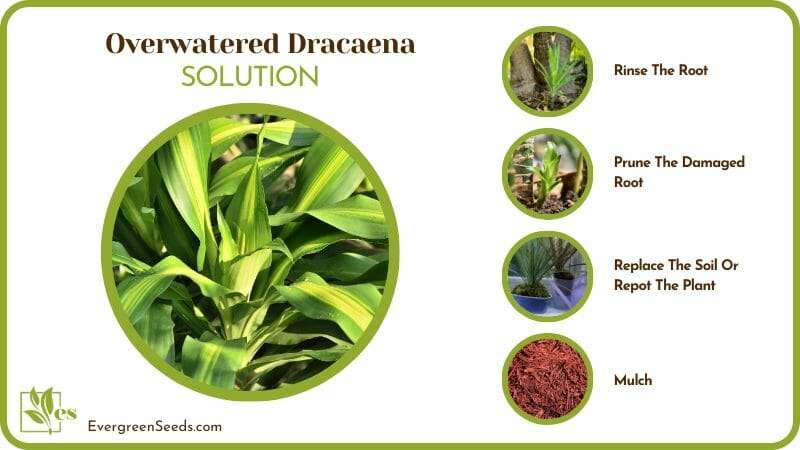An overwatered dracaena is a severe concern for planters and gardeners. It happens mainly due to poor drainage systems and too much water around the Dracaena genus plant.

The tree may become yellowish or have rotten roots due to too much dampness or water around it. Our comprehensive guide offers crucial tips on saving overwatered Dracaena.
What Are the Signs of Overwatered Dracaena?
Overwatered Dracaena signs are the plant develops root rot, discoloration or yellowing of the leaves, and the slowing of the growth rate. In addition, the drooping of the leaves and browning or soft rot, and developing of mold or mildew.
– Root Rot Incident
When you overwater the dracaena, the ultimate effect is seen in the root. Due to too much water around the root for too long, it starts to rot. As the soil receives excess water, it becomes moist. Slowly, the moisture builds around the rot.
With inappropriate drainage, the soil will remain moist for an extended period. It will start rotting the root. If you fail to identify and fix the problem, the entire root will become rotten. Ultimately, the plant will face an immature death.
It happens because too much moisture around the root stops the fresh oxygen flow. As a result, viruses and bacteria develop around the root without oxygen. Now, it is key to know that it causes the root to start rotting, and when this happens the plant cannot transmit proper nourishment to the leaves.
There are three ways that you can identify that root rot has occurred: You may smell a foul odor due to the bacterial and fungal attack. The roots will become spongy and soft, and lastly, they may become too dark or brown as it loses their original color.
– Discoloration And Yellowing of The Leaves
Yellowing and discoloration of the dracaena leaf are common issues for overwatering issues. As the soil becomes moist, it damages the root. Thus, the plant leaves fail to consume the necessary nutrients from the soil.
Plus, the leaves are deprived of oxygen due to moisture development. So, they become yellowish. You can observe the foliage and see it happening.
Usually, the foliage is shiny. It also has a bright hue with green, lime, and burgundy colors. As the soil becomes too moist, the vibrant hue of the foliage and leaves starts turning brown and yellowish.
However, the yellowish leaves of the plant would show that the foliage has gotten tired, and the chlorophyll level has been diluted and become pale as a result of the leaves turning yellow.
Thus, knowing if you have overwatered the tree is not a definite sign. For this, you should look and examine the leaf tip of it carefully, the tip of the leave will be slightly brownish.

– Slow Growth Rate
With an overwatering problem, dracaena may face a slow growth rate. Since overwatering the plant will destroy its root, it will fail to absorb the necessary nutrients from any type of soil. As it will lack all the necessary growth ingredients, the plant will grow slower than usual.
However, it is indeed a challenging observation since the plant already had a slow growth rate. You may use a scale to measure the leave and plant growth. You are watering the plant too generously when the growth rate is slower than expected. Since they have too much water, they won’t have enough nutrients or minerals to grow properly and reach their ideal height.
– Drooping Leaves
Due to overwatering and blocking the necessary nutrients from the root, the leaves will start dropping and drooping.
Also, the stems are like a long trunk. It has a narrow and long shape. When you overwater the plant, and its trunk and root absorb too much water, it becomes floppy and limp. As a result, the leaves become droopy.
When you see the leaves drooping even after a few hours of watering the plant, it suggests an overwatering problem. It happens because the plant root still consumes more than the required water even after the soil soaks it.
In fact, the soil and drainage fail to remove the excess water. Finally, it reaches the plant leaves, and they will be on the stem but tired-looking; henceforth, you should try looking for drooping leaves if you suspect overwatering the indoor plants.
– Soft And Brown Rot
Likewise, the rotten root and the stems may also start rotting. The stems will turn swollen and mushy if the issue is overwatering the plant. Ultimately, the stems will have brown spots and become softer than usual.
The brown leaves and spots will also be visible in the foliage and other parts. This indicates that the plant is facing concerns due to overwatering. When the excess water remains too long in the soil, it will gradually attack all parts of the plant. So, you must be aware of it.
– Mold And Mildew On The Soil Surface
Another vivid indication of an overwatering event is mold growth on the soil surface. As poor drainage fails to remove additional water from the soil, it makes the surface wet. This soil surface wetness becomes the breeding ground of fungus, mold, and mildew.
At first, you will see a thin wooly layer on the soil surface. Slowly, the layer becomes thicker, extending to the stems and top parts of the plant. This mold growth will block oxygen, and the plant will die slowly.
How To Fix Overwatered Dracaena
Fixing the overwatered Dracaena would be to fix removing and inspect the roots, rinsing the roots, and pruning them, then, you must replace the soil with well-draining soil. Lastly, don’t forget to add mulch and adopt a proper watering schedule.
– Remove And Inspect The Dracaena Root
Remove the plant from its pot or soil first. Usually, the plant has strong roots, and you will find it hard to remove it from the soil. Thus, you must carefully remove the top surface of the soil.
Once you remove the topsoil from the pot or planted place, you can access the root. Now, tilt the plant and then wiggle it. As the root becomes slightly softer, you may try removing it from the soil and pot. After removing the root from the pot, scrutinize it.

Dracaena leaves will grow once you remove the dead leaves. The new leaves will grow from the crown and give the tree its perfect foliage. When you inspect all these incidents, you will be sure about overwatering problem of the Dracaena plant.
– Rinse The Root
As you remove the root rot of the plant from the soil, you need to remove the remaining soil from it. Otherwise, you can’t inspect it. So, with your hand, remove the soil. Then, use warm water to clean the root.
As you bathe the root with warm water, you may see it. It helps you in inspecting the root better. The roots will calm down and the issue will be eliminated.
– Prune The Damaged Root
Once you start observing the rotten root, you can see the level of damage on it. You should identify the mushy and soft parts of the root. Then, use a proper cutting tool to cut off the mushy parts from the root.
Make sure that the cutting tool is sharp and clean. It will damage the root and stem further if it is not sharp. Also, use a bleach solution to sterilize the cutting tool after you cut each part of the root. To prepare the sterilizing solution, you should use nine parts of distilled water and one part of bleach.
After cutting off the damaged parts from the dracaena roots, you must clean the other affected parts. For instance, look for any brown or discolored leaf and remove it with your hand. If there’s a brown or black spot on any part, get rid of it with care.
You must understand that the dracaena plant’s brown or black spots are diseased. If you don’t remove them, they will spread to the other parts of the plant. Overall, your effort to revive the plant from overwatering problems will become futile.
– Replace The Soil Or Repot The Plant
You should dry the soil in natural sunlight for a couple of hours. It helps the soil to become drier. Or, you may use new soil, too. Plus, you must check the drainage hole of the older Pot. If it has become clogged, you must unclog it.
Alternatively, you may use a new pot to replant the dracaena there. Just keep in mind that you must remove any diseased parts of the dying foliage first. Then, you should try mimicking the plant’s natural habitat to help it revive.
In indoor conditions, we grow dracaena in small pots. These pots usually have a tiny hole in the bottom that removes the extra water. Sometimes the hole may get clogged. Water will remain inside the pot and dampen the soil when it happens. As the holes in the pot can’t remove the excess water, it develops around the plant’s root. Thus, the plant becomes overwatered.
– Mulch
You may even add mulch on top of the soil that is well-draining because mulch will keep the moisture level of the plant, and it will help the growth and the blooming. Your plant will feel safer and thrive as the soil is perfectly watered and the roots are healthy. The mulch will give it an even layer of humidity throughout the next time it will be irrigated.

– Watering schedule
What you must remember when it comes to the waiting of this plant is that you should not constantly water. To keep this in mind you should have a watering schedule, every 10 to 14 days, as the soil feels dry, it should be watered.












